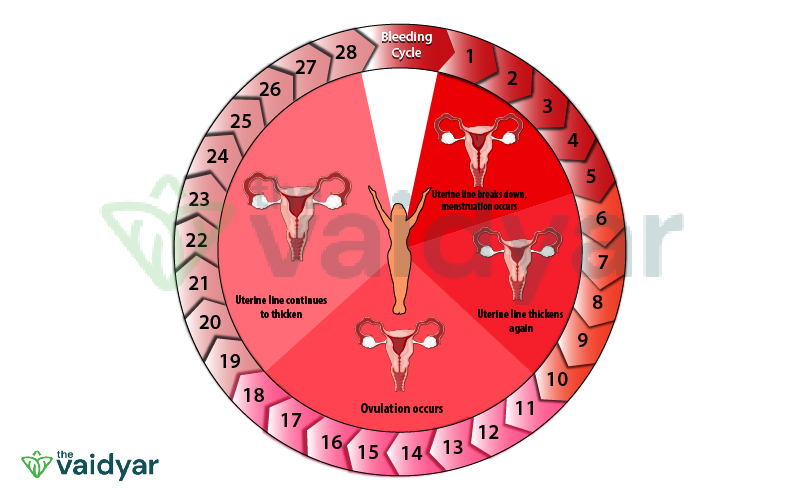How To Maintain Healthy Menstrual Cycle Through Ayurveda
Any Information you see will be valuable to someone today. Please share and Stay Connected.

Introduction
The menstruation cycle refers to the cycles in which a woman's uterus grows and sheds a lining that could support the development of a fertilized egg. It typically occurs in 28-day cycles, so a woman generally gets her period every 28 days.
Healthy menstruation, according to Ayurveda, lasts a few days and occurs every 28 days, from around the age of 12 until around 50. Variations on this can occur due to imbalances in the Doshas, the mind-body energies that govern everything. These three Doshas, Vata, Pitta, and Kapha, describe the forces of nature both inside and outside our bodies as well as our genetic makeup and it is in our interest to make lifestyle choices that keep them in balance.
Our Doctors
Online Consultation
Ayurveda Says About Healthy Menstrual Flow
As per Ayurveda, a healthy menstrual flow has the following characteristics
- Bright red.
- Do not stain clothing (a common characteristic of ama, or toxic, unprocessed substance in our body that clogs channels and creates dysfunction).
- Has an odor that is not foul.
Phases Of The Menstrual Cycle
The four main phases of the menstrual cycle are:
- Menstruation
Menstruation is the elimination of the thickened lining of the uterus (endometrium) from the body through the vagina. The menstrual fluid contains blood, cells from the lining of the uterus (endometrial cells), and mucus. The average length of a period is between three days and one week.
- The follicular phase
The follicular phase starts on the first day of menstruation and ends with ovulation. Prompted by the hypothalamus, the pituitary gland releases follicle-stimulating hormone (FSH). This hormone stimulates the ovary to produce around five to 20 follicles (tiny nodules or cysts), which bead on the surface.
- Ovulation
Ovulation is the release of a mature egg from the surface of the ovary. This usually occurs mid-cycle, around two weeks or so before menstruation starts.
- The luteal phase
During ovulation, the egg bursts from its follicle, but the ruptured follicle stays on the surface of the ovary. For the next two weeks or so, the follicle transforms into a structure known as the corpus luteum. This structure starts releasing progesterone, along with small amounts of estrogen. This combination of hormones maintains the thickened lining of the uterus, waiting for a fertilized egg to stick (implant).
Different phases mentioned in the menstruation cycle are Menstruation, follicular phase, ovulation, and luteal phase.
Guidelines For A Healthy Menstrual Cleanse
- Eat a simple diet
You want to reserve all of your body’s digestive fire for cleansing. Eating kitchari and other warm, thoroughly cooked meals will be helpful for the body’s digestion. Spices, such as ginger, cardamom, saffron, cumin, coriander, fennel, and cinnamon must be included in your diet.
- Honor yourself with rest and rejuvenation
Cleansing involves the movement of wastes down and out of the body and we want to be sure that that directional flow is not counteracted by upward movements, like excessive talking or thinking sexual intercourse, and even pranayama and yoga. These activities also take up a lot of energy and your body needs to use all of its reserve energy towards cleansing.
Don’t suppress urges, like urination, defecation, and sneezing. If you are suppressing all these urges it will promote Vata to go opposite of its normal downward flow.
Reflect And Meditate
- Hydrate
Hydration has great importance to move wastes. During a menstrual cleanse, hydrate with warm teas, such as ginger tea, lemon tea with honey, or CCF tea (cumin, coriander, and fennel) .
- Pranayama
Pranayama is very useful during menstruation as it helps to balance emotions and calm the mind. It can also help one to deal with any pain. The ideal time for doing pranayama is to do twenty minutes before sleeping.
- Yoga
A strong yoga practice is very helpful to balance the doshas effect caused during the menstruation cycle. It will keep your body strong and limber, removing physical blockages for pranic flow. Poses particularly great for the female reproductive system are Child’s Pose (Balasana), Butterfly’s Pose (Baddha Konasana), Bridge Pose (Setu Bandhasana), Plow (Halasana), and reclining Hero (Supta Virasana).
Some of the basic guidelines that are helpful during menstruation are eating a simple diet, rest and rejuvenation, yoga, pranayama, meditation, don’t suppress urges, like urination, defecation, and sneezing, etc.
Conclusion
The information related to a healthy menstruation cycle is based on various Ayurvedic resources. Always seek the advice of an Ayurvedic practitioner before starting any Diet or Ayurvedic herbs for the management of a healthy menstruation cycle.











